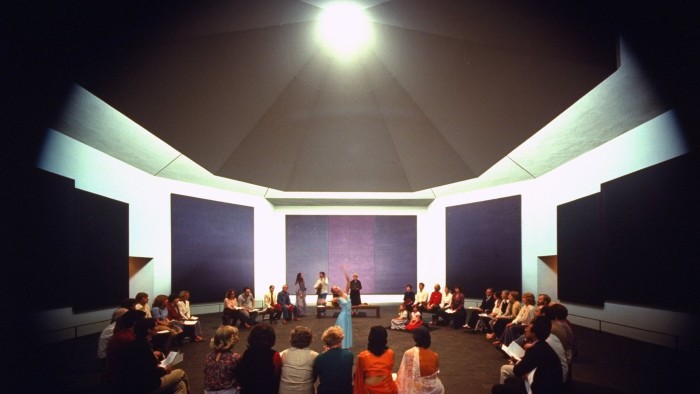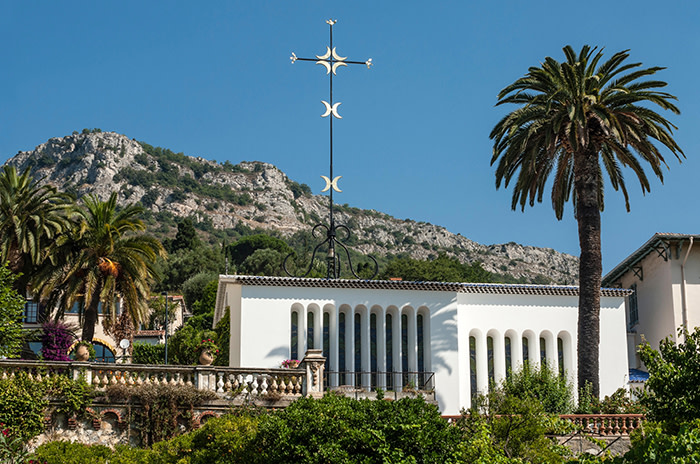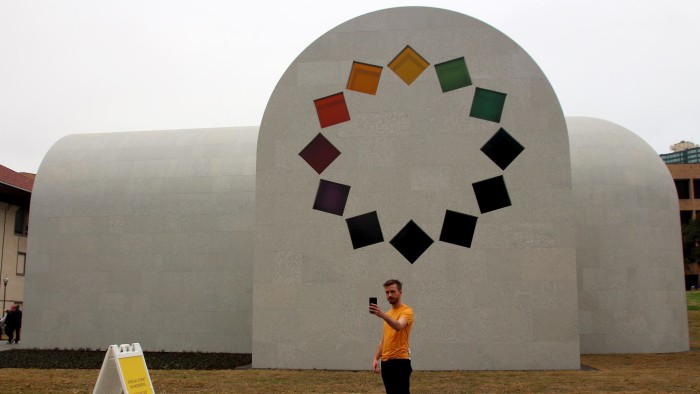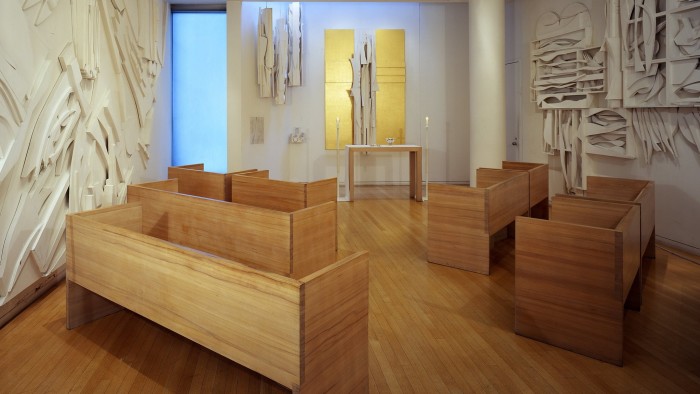Sacred art: seek out six artists’ chapels

Roula Khalaf, Editor of the FT, selects her favourite stories in this weekly newsletter.
In 1941, when Henri Matisse was recovering from cancer surgery, his advertisement for “a young and pretty nurse” was answered by Monique Bourgeois. An unusual friendship grew, and several years later, when Bourgeois had entered the order of Dominican nuns at Vence, in the south of France, she asked the 77-year-old Matisse for help in designing a chapel that the nuns wanted to build for their school.
The result, the Chapelle du Rosaire, finished in 1951, is a small, white, L-shaped building whose fiercely plain interior is flooded by glorious light from Matisse’s stained glass windows, created in just three colours — blue, yellow, green — that evoke the Mediterranean setting.
Working obsessively on the project, for which he designed every detail (down to the bronze crucifix on the altar and the priests’ vestments), Matisse called it his masterpiece.
The intimate links between art and religious sites stretch back to the very beginnings of western cultural history, and culminated during the Renaissance in such jewels as Michelangelo’s Sistine Chapel. But perhaps it is more surprising to be reminded that even in a secular modern age, when art has rebelliously cast off any remaining religious shackles, artists are often drawn to creating work for sacred buildings.
Small chapels, especially, provide a powerful locus for an artist’s eye, and a perfect showcase for their work. Visiting these chapels can often be a more vivid experience than a mighty cathedral — perhaps because, like Matisse’s chapel in Vence, many came into existence through a particular set of emotional circumstances.

The Sandham Memorial chapel in Burghclere, Hampshire, carries such a story. The small brick building was created by Mary and Louis Behrend in memory of Mary’s brother, Lieutenant Henry Willoughby Sandham, a casualty of the first world war. Commissioning Stanley Spencer to fill it with paintings was a bold move but the result — 17 fresco-like panels, culminating in a floor-to-ceiling Resurrection — is perhaps the most glorious way to see this artist’s work.
Spencer, who called the place his “God-box”, was inspired, he said, by Giotto’s Arena chapel in Padua but transformed his own mundane wartime experiences as a hospital orderly — soldiers making beds and mopping floors, mules pulling carts, wounded men smoking, cooking, brushing their teeth — into this transcendent work, making it a memorial for not just one fallen soldier, but for millions.
Memories of the dead are often a powerful impetus for artists. A stunning contemporary example is James Turrell’s light installation at the Dorotheenstadt Cemetery Memorial Chapel in Berlin, which harnesses the natural effects of summer sunsets for a mesmerisingly beautiful display.
Another memorial was the springboard for Marc Chagall’s 12 stained glass windows in Tudeley church, in Kent, commissioned by the family of Sarah d’Avigdor-Goldsmid who died in a sailing accident aged just 21. The elderly Chagall (a Jewish artist chosen by this Anglo-Jewish family) reluctantly took the commission for a single window in 1967, but fell in love with the site and, by his death in 1985 at the age of 98, had completed this unique set of dazzling glass.

Pablo Picasso was not so much one to take a commission as to seize an opportunity. While living in the southern French town of Vallauris in the late 1940s, he became enchanted by the vaulted Romanesque chapel of the local château. There he decided to make one of his great statements about conflict with a “Temple of Peace” whose giant panels (of more than 100 square metres) curve across the vaults depicting the horrors of war and his hopes for peace. It is, for this artist, an unusual foray into the sacred.
Each of these places has its unique, intense atmosphere, fostered by the artist. As collector Dominique de Menil put it, talking of commissioning work by the great American artist Mark Rothko for a non-denominational chapel in Houston, Texas: “We saw what a great master can do for a religious building when he is given a free hand. He can exalt and uplift as no one else.”
Yet here we begin to see how fine a line divides the secular from the sacred. Is this a chapel, or a complete piece of modern art? Rothko’s 14 murals, ranged around an octagonal cruciform structure, are themselves the objects of pilgrimage, perhaps even worship. Art, as has often been noted, has become a sacred commodity in our often faithless contemporary world, and galleries the new cathedrals.

In this way, the Chapel Of The Good Shepherd at Saint Peter’s Church in Manhattan can be seen as a sort of crossover. This tiny sanctuary within the city, measuring just 28 by 21 feet, is a Christian space created by a Jewish artist, the late Louise Nevelson, and is described as “a comprehensive sculptural environment”, a spiritual modernist treasure in whites and pale wood tones.
And the transition from sacred to secular is even more complete in Ellsworth Kelly’s “chapel” at Austin, Texas. Kelly’s final work before his death in 2015 was this freestanding limestone pavilion, vaulted like a chapel, illuminated by brilliant shards of coloured light from his stained glass windows and clearly inspired by the European Romanesque — but dedicated purely to an aesthetic spirituality, rather than a specific religious purpose.
Visiting such contemplative spaces, whether for the religion or the art or the confluence of the two, can be deeply rewarding: a sightseeing experience that goes far beyond the usual or the mundane. “Exalt and uplift”, indeed.
Jan Dalley is the FT’s Arts Correspondent
Comments